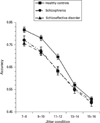Cognition in schizophrenia and schizo-affective disorder: impairments that are more similar than different
- PMID: 23522057
- PMCID: PMC4149253
- DOI: 10.1017/S0033291713000536
Cognition in schizophrenia and schizo-affective disorder: impairments that are more similar than different
Abstract
Background: Cognition is increasingly being recognized as an important aspect of psychotic disorders and a key contributor to functional outcome. In the past, comparative studies have been performed in schizophrenia and schizo-affective disorder with regard to cognitive performance, but the results have been mixed and the cognitive measures used have not always assessed the cognitive deficits found to be specific to psychosis. A set of optimized cognitive paradigms designed by the Cognitive Neuroscience Test Reliability and Clinical Applications for Schizophrenia (CNTRACS) Consortium to assess deficits specific to schizophrenia was used to measure cognition in a large group of individuals with schizophrenia and schizo-affective disorder.
Method: A total of 519 participants (188 with schizophrenia, 63 with schizo-affective disorder and 268 controls) were administered three cognitive paradigms assessing the domains of goal maintenance in working memory, relational encoding and retrieval in episodic memory and visual integration.
Results: Across the three domains, the results showed no major quantitative differences between patient groups, with both groups uniformly performing worse than healthy subjects.
Conclusions: The findings of this study suggests that, with regard to deficits in cognition, considered a major aspect of psychotic disorder, schizophrenia and schizo-affective disorder do not demonstrate major significant distinctions. These results have important implications for our understanding of the nosological structure of major psychopathology, providing evidence consistent with the hypothesis that there is no natural distinction between cognitive functioning in schizophrenia and schizo-affective disorder.
Figures



Similar articles
-
Neuropsychological impairments in schizophrenia and psychotic bipolar disorder: findings from the Bipolar-Schizophrenia Network on Intermediate Phenotypes (B-SNIP) study.Am J Psychiatry. 2013 Nov;170(11):1275-84. doi: 10.1176/appi.ajp.2013.12101298. Am J Psychiatry. 2013. PMID: 23771174 Free PMC article.
-
Temporal stability and moderating effects of age and sex on CNTRaCS task performance.Schizophr Bull. 2014 Jul;40(4):835-44. doi: 10.1093/schbul/sbt089. Epub 2013 Jul 1. Schizophr Bull. 2014. PMID: 23817024 Free PMC article.
-
Variability in working memory performance explained by epistasis vs polygenic scores in the ZNF804A pathway.JAMA Psychiatry. 2014 Jul 1;71(7):778-785. doi: 10.1001/jamapsychiatry.2014.528. JAMA Psychiatry. 2014. PMID: 24828433 Free PMC article.
-
Memory and cognition in schizophrenia.Mol Psychiatry. 2019 May;24(5):633-642. doi: 10.1038/s41380-018-0231-1. Epub 2018 Sep 21. Mol Psychiatry. 2019. PMID: 30242229 Free PMC article. Review.
-
Cognitive Deficits in Psychotic Disorders: A Lifespan Perspective.Neuropsychol Rev. 2018 Dec;28(4):509-533. doi: 10.1007/s11065-018-9388-2. Epub 2018 Oct 20. Neuropsychol Rev. 2018. PMID: 30343458 Free PMC article. Review.
Cited by
-
Cognitive impairments in psychotic disorders: common mechanisms and measurement.World Psychiatry. 2014 Oct;13(3):224-32. doi: 10.1002/wps.20145. World Psychiatry. 2014. PMID: 25273286 Free PMC article.
-
Reduced Visual Function in Schizotypal Traits: An Exploratory Study.Schizophr Bull. 2025 Mar 4;51(Suppl 2):S205-S213. doi: 10.1093/schbul/sbae049. Schizophr Bull. 2025. PMID: 40037828 Free PMC article.
-
Retrieval practice facilitation of family psychoeducation in people with early psychosis.Schizophr Res. 2020 Sep;223:186-191. doi: 10.1016/j.schres.2020.07.016. Epub 2020 Jul 29. Schizophr Res. 2020. PMID: 32739345 Free PMC article.
-
Cognitive and perceptual impairments in schizophrenia extend to other psychotic disorders but not schizotypy.Schizophr Res Cogn. 2022 Aug 5;30:100266. doi: 10.1016/j.scog.2022.100266. eCollection 2022 Dec. Schizophr Res Cogn. 2022. PMID: 35959485 Free PMC article.
-
Multiple forms of contour grouping deficits in schizophrenia: what is the role of spatial frequency?Neuropsychologia. 2014 Dec;65:221-33. doi: 10.1016/j.neuropsychologia.2014.10.031. Epub 2014 Nov 1. Neuropsychologia. 2014. PMID: 25446968 Free PMC article.
References
-
- Amann B, Gomar JJ, Ortiz-Gil J, McKenna P, Sans-Sansa B, Sarro S, Moro N, Madre M, Landin-Romero R, Vieta E, Giokolea JM, Salvador R, Pomarol-Clotet E. Executive dysfunction and memory impairment in schizoaffective disorder: a comparison with bipolar disorder, schizophrenia and healthy controls. Psychological Medicine. 2012;42:2127–2135. - PubMed
-
- Barch DM, Carter CS, Arnsten A, Buchanan RW, Cohen JD, Geyer M, Green MF, Krystal JH, Nuechterlein K, Robbins T, Silverstein S, Smith EE, Strauss M, Wykes T, Heinssen R. Selecting paradigms from cognitive neuroscience for translation into use in clinical trials: proceedings of the third CNTRICS meeting. Schizophrenia Bulletin. 2009;35:109–114. - PMC - PubMed
Publication types
MeSH terms
Grants and funding
- R01 MH084826/MH/NIMH NIH HHS/United States
- MH084840/MH/NIMH NIH HHS/United States
- R01 MH084821/MH/NIMH NIH HHS/United States
- MH059883/MH/NIMH NIH HHS/United States
- R01 MH084861/MH/NIMH NIH HHS/United States
- MH084826/MH/NIMH NIH HHS/United States
- MH084861/MH/NIMH NIH HHS/United States
- MH084828/MH/NIMH NIH HHS/United States
- R01 MH059883/MH/NIMH NIH HHS/United States
- MH08482/MH/NIMH NIH HHS/United States
- R01 MH084840/MH/NIMH NIH HHS/United States
- R01 MH084828/MH/NIMH NIH HHS/United States
- T32 MH014677/MH/NIMH NIH HHS/United States
LinkOut - more resources
Full Text Sources
Other Literature Sources
Medical
Miscellaneous

